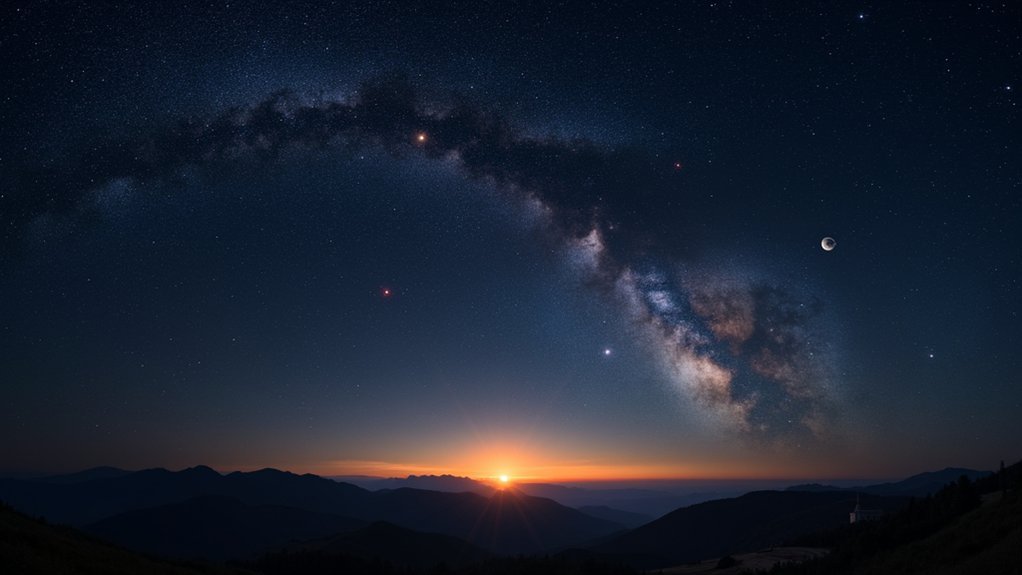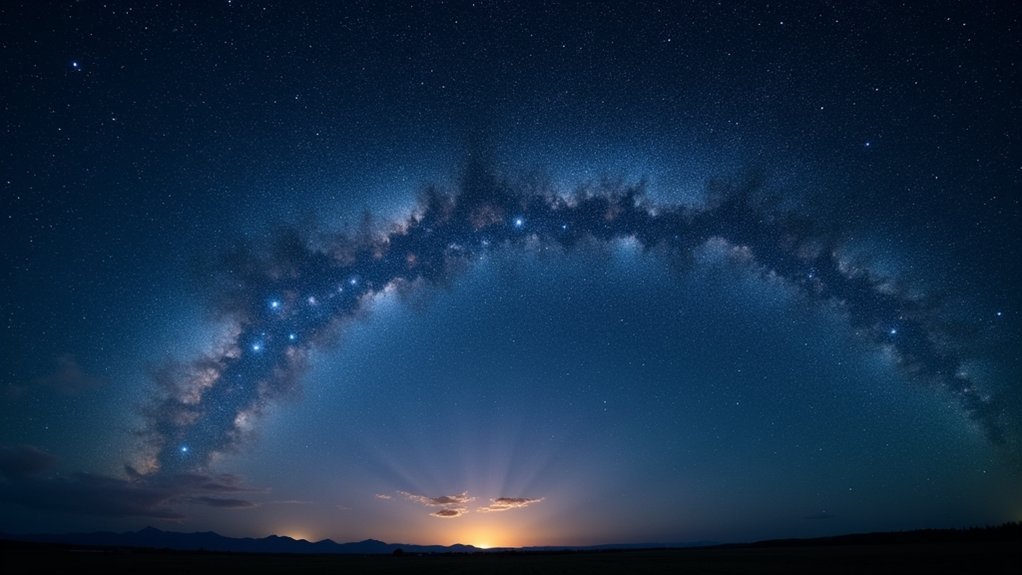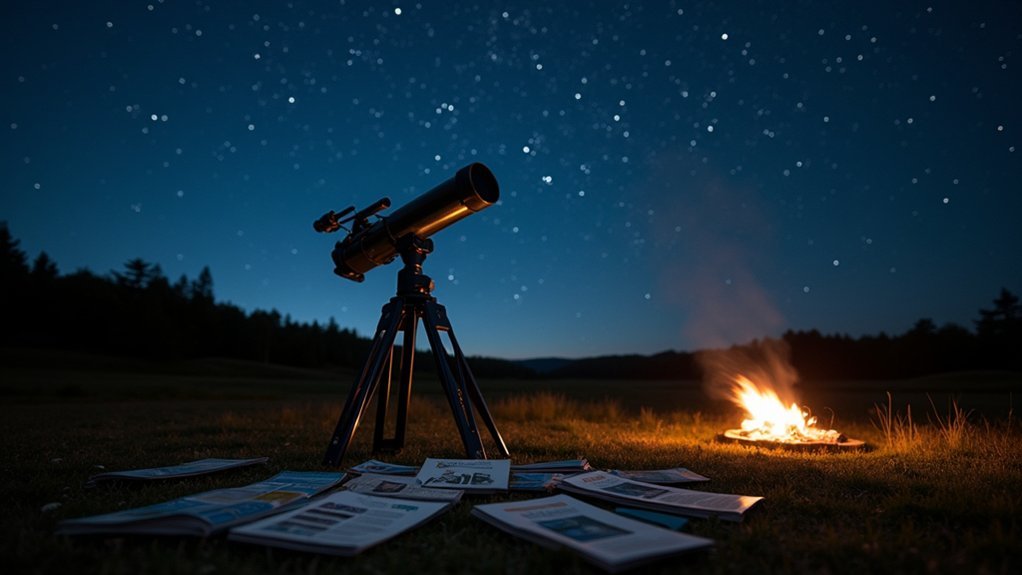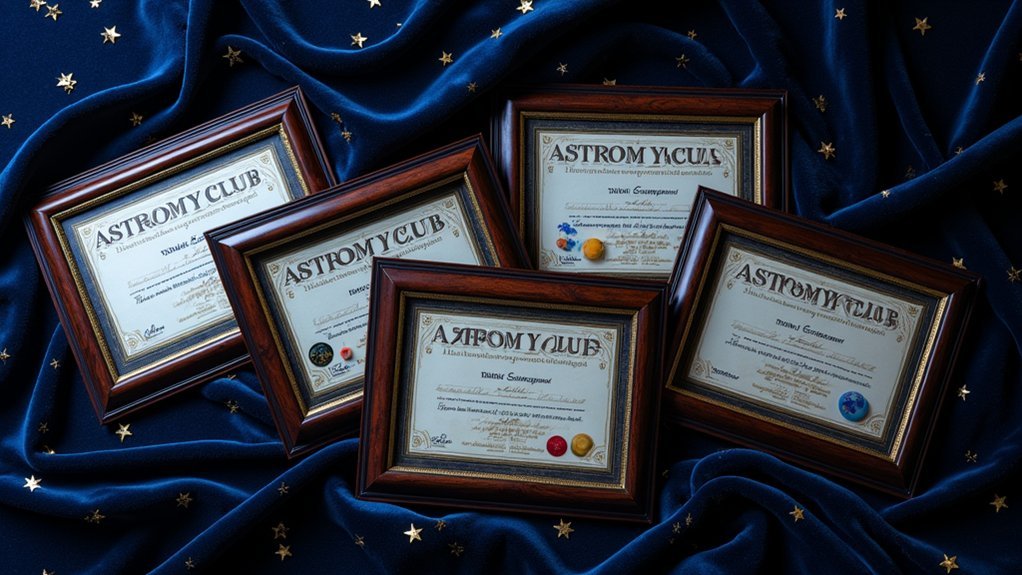Tonight’s sky offers a planetary showcase with Jupiter glowing in the western sky and reddish Mars setting a few hours later. Venus shines brilliantly in the pre-dawn eastern sky, approaching its greatest brilliancy on April 27. You’ll also spot the waxing gibbous moon near the bright star Regulus. Look for the distinctive Big Dipper to help orient yourself. The night holds even more celestial treasures for patient observers.
Prominent Planets and Their Locations This Month

Where should you look to spot our solar system’s brightest members this month?
Jupiter dominates the western sky during April evenings, remaining visible until about three hours after sunset by month’s end. Look almost directly overhead to find reddish Mars, which sets a few hours after Jupiter and is currently moving through Cancer toward the Beehive star cluster.
Early risers will enjoy Venus in the morning sky, rising about an hour before the sun.
Mark April 27 on your calendar when Venus reaches its greatest brilliancy—a spectacle you won’t see again until November 2026.
The morning show continues on April 29 when Venus and Saturn appear just four degrees apart. Mercury joins these morning planets along the ecliptic, completing the planetary parade.
Moon Phases and Celestial Meetings
Throughout April, the moon serves as your celestial tour guide, highlighting notable stars and constellations as it journeys across the night sky.
On April 7-8, you’ll spot the waxing gibbous moon partnering with bright star Regulus in Leo, creating a stunning celestial sight. The year’s smallest full moon arrives on April 11-12 at 7:22 p.m. CDT, positioned over 400,000 km away.
Watch for the waning gibbous moon near red Antares and Zubenelgenubi on April 13-14.
Look skyward April 13-14 as the waning gibbous moon glides past crimson Antares and distinctive Zubenelgenubi.
As mid-month approaches, the moon will showcase the distinctive Teapot asterism in Sagittarius on April 18-19.
Early risers should mark April 24-25 on their calendars when the delicate crescent moon hangs above Venus and Saturn just before sunrise, offering a perfect finale to April’s lunar performances.
Key Constellations to Guide Your Stargazing

While the moon offers a changing nightly spectacle, several steadfast constellations remain visible throughout April, serving as reliable landmarks in your stargazing adventures. The Big Dipper helps you locate the North Star and navigate to other bright stars across the night sky guide.
Look for Leo with its distinctive backward question mark shape called the Sickle, featuring Regulus at its base. On April 11-12, you’ll find Virgo’s bright star Spica positioned below the moon. The Teapot in Sagittarius will appear near the moon on April 18-19, marking our galaxy’s center.
| Constellation | Notable Feature | Best Viewing | Finding Aid |
|---|---|---|---|
| Orion | Three-star Belt | Early evening | Western horizon |
| Leo | Sickle shape | All night | Follow Big Dipper |
| Virgo | Spica | After sunset | Near moon (Apr 11-12) |
| Sagittarius | Teapot asterism | Late evening | Near moon (Apr 18-19) |
Meteor Showers and Special Astronomical Events
April’s night skies offer more than just planets and constellations, as the Lyrid meteor shower highlights this month’s celestial events.
You’ll want to mark April 21-22, 2025 on your calendar, when the Lyrids reach their peak. The best viewing time starts after 10:30 PM and continues until dawn, with ideal conditions around 5 AM.
Find a spot away from city lights to experience dark skies where you’ll catch up to 15 meteors per hour radiating from near bright star Vega in Lyra. The waning crescent moon in Capricornus will provide a darker backdrop for better visibility.
Plan extended viewing sessions around April 27, when a new supermoon occurs at 19:31 UTC—one of five in 2025—further enhancing viewing conditions for the Lyrid meteors.
Using Star Charts to Navigate the Night Sky

Steering through April’s night sky becomes much easier with star charts as your guide.
Navigating April’s celestial wonders becomes effortless when armed with detailed star charts.
You’ll find bright stars like Regulus in Leo and Spica in Virgo highlighting this month’s celestial landscape. Don’t miss Jupiter setting three hours after sunset, while other planets create a stunning display.
For enhanced stargazing this April:
- Use star charts to locate the Lyrid meteor shower peaking April 21-22, with meteors radiating near Vega in Lyra.
- Track the moon’s phases, especially the Pink Moon on April 12, 2025—the year’s smallest full moon at over 400,000 km away.
- Pair your star chart with Stellarium Online for precise viewing times of night sky events.
- Identify visible planets and constellations for ideal viewing experience based on your location.
Frequently Asked Questions
What Is the Brightest Thing in the Sky Tonight?
You’ll see Venus shining as the brightest object in tonight’s sky. It’s prominently displayed in the eastern sky before sunrise, outshining all other celestial bodies during April mornings.
What Is the Bright Planet in the Night Sky?
Venus is the brightest planet you’ll see in the night sky. You can spot it rising in the east before sunrise. Jupiter and Mars are also quite bright if you’re looking in the evening.
Why Is Jupiter so Visible Right Now?
Jupiter’s so visible because it’s positioned high in the western sky, setting three hours after sunset in April. You’ll easily spot its brilliant -2.1 magnitude near Aldebaran, enhanced by its reflective clouds.
In Summary
You’re now equipped to enjoy the celestial show above you tonight. Whether you’re tracking Jupiter’s position, watching for meteors, or identifying constellations, the night sky offers a personal connection to our universe. Don’t forget your star chart as you head outside! With each planet and star you locate, you’re participating in humanity’s oldest form of wonder and discovery.





Leave a Reply